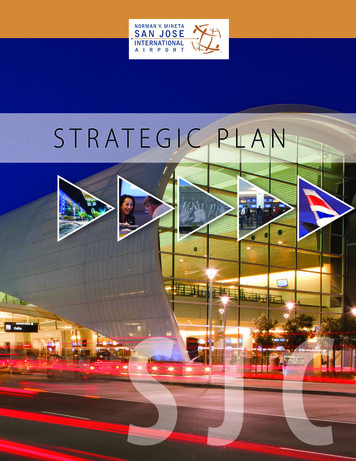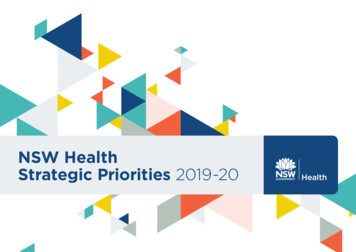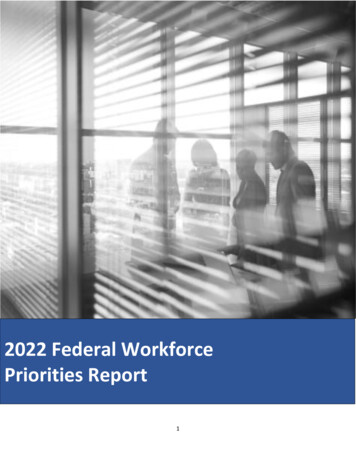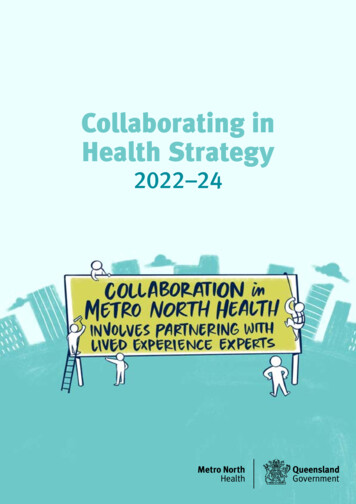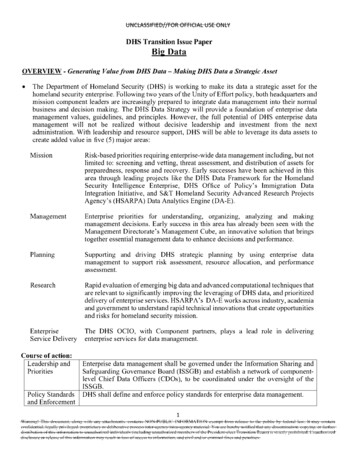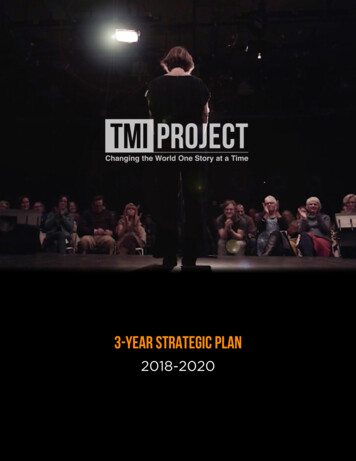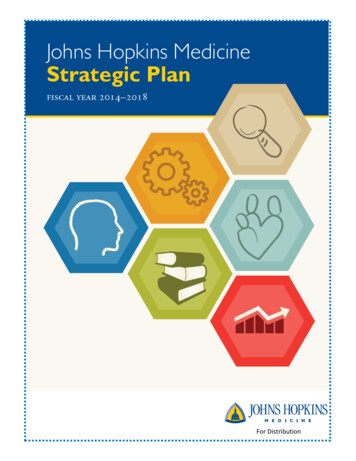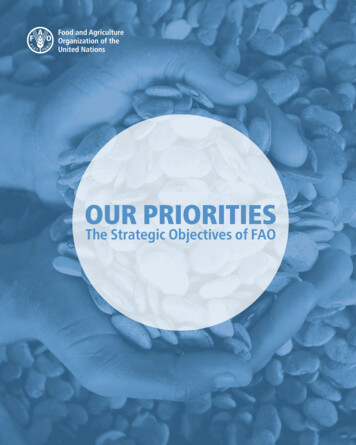
Transcription
Required citation:FAO. 2019. Our priorities – The Strategic Objectives of FAO. Rome. 28 pp. Licence: CC BY-NC-SA 3.0 IGO.The designations employed and the presentation of material in this information product do not imply the expressionof any opinion whatsoever on the part of the Food and Agriculture Organization of the United Nations (FAO)concerning the legal or development status of any country, territory, city or area or of its authorities, or concerningthe delimitation of its frontiers or boundaries. The mention of specific companies or products of manufacturers,whether or not these have been patented, does not imply that these have been endorsed or recommended by FAOin preference to others of a similar nature that are not mentioned.The views expressed in this information product are those of the author(s) and do not necessarily reflect the views orpolicies of FAO. FAO, 2019Some rights reserved. This work is made available under the Creative Commons Attribution-NonCommercialShareAlike 3.0 IGO licence (CC BY-NC-SA 3.0 IGO; igo/legalcode/legalcode).Under the terms of this licence, this work may be copied, redistributed and adapted for non-commercial purposes,provided that the work is appropriately cited. In any use of this work, there should be no suggestion that FAOendorses any specific organization, products or services. The use of the FAO logo is not permitted. If the work isadapted, then it must be licensed under the same or equivalent Creative Commons licence. If a translation of thiswork is created, it must include the following disclaimer along with the required citation: “This translation was notcreated by the Food and Agriculture Organization of the United Nations (FAO). FAO is not responsible for thecontent or accuracy of this translation. The original [Language] edition shall be the authoritative edition.”Disputes arising under the licence that cannot be settled amicably will be resolved by mediation and arbitration asdescribed in Article 8 of the licence except as otherwise provided herein. The applicable mediation rules will be themediation rules of the World Intellectual Property Organization http://www.wipo.int/amc/en/mediation/rules andany arbitration will be conducted in accordance with the Arbitration Rules of the United Nations Commission onInternational Trade Law (UNCITRAL).Third-party materials. Users wishing to reuse material from this work that is attributed to a third party, such astables, figures or images, are responsible for determining whether permission is needed for that reuse and forobtaining permission from the copyright holder. The risk of claims resulting from infringement of any third-partyowned component in the work rests solely with the user.Sales, rights and licensing. FAO information products are available on the FAO website (www.fao.org/publications) and can be purchased through publications-sales@fao.org. Requests for commercial use should besubmitted via: www.fao.org/contact-us/licence-request. Queries regarding rights and licensing should be submittedto: copyright@fao.org.This publication has been printed using selected products and processes so as to ensure minimal environmentalimpact and to promote sustainable forest management.Cover photo: FAO/Peter DiCampo
OUR PRIORITIES THE FAO STRATEGIC OBJECTIVESOUR STRATEGICOBJECTIVESToday, member states face an increasing number ofdemands and challenges in agricultural development.To support them, FAO has identified five keypriorities on which it is best placed to intervene.These priorities, or Strategic Objectives, representour main areas of work to achieve our vision of aworld free from hunger and malnutrition, where foodand agriculture help to improve the living standardsof all, especially the poorest, in an economically,socially and environmentally sustainable manner– contributing to the implementation of the 2030Agenda for Sustainable Development.HELP ELIMINATE HUNGER,FOOD INSECURITY AND MALNUTRITIONMAKE AGRICULTURE, FORESTRY AND FISHERIESMORE PRODUCTIVE AND SUSTAINABLEREDUCE RURAL POVERTYENABLE INCLUSIVE AND EFFICIENTAGRICULTURAL AND FOOD SYSTEMSINCREASE THE RESILIENCE OF LIVELIHOODSTO THREATS AND CRISESFor more information on the overarching strategic direction of FAO, see the Reviewed Strategic Framework 2010-19.3
OUR PRIORITIES THE FAO STRATEGIC OBJECTIVESTHE STRATEGICFRAMEWORK OF FAOTo help accomplish our Strategic Objectives, FAO works through five Strategic Programmesleveraging our core functions to achieve concrete results. The Organization's technicalknowledge and expertise underpins everything we do, while fully integrating ourcross-cutting themes of gender, governance, nutrition and climate change impacts in allaspects of our work.GenderWe aim to close the gendergap in agriculture, therebygenerating significant gains forthe agricultural sector andhelping to reduce hunger,malnutrition and poverty.GovernanceWe aim to strengtheninteractions betweenstakeholders and makeparticipation in theimprovement of governance awidely shared, mutual learningprocess.Climate changeWe aim to help agriculturalsectors respond to thechallenges posed by climatechange, in order ensuresustainable development.NutritionWe aim to eliminatemalnutrition in all its forms, asa basis for good health andsocial and economicdevelopment.Strategic Programme 5INCREASE THE RESILIENCEOF LIVELIHOODS TO THREATSAND CRISESPages 22-23-24-25Strategic Programme 4ZERO HUNGER,NO POVERTYAND SUSTAINABLEUSE OF NATURALRESOURCESENABLE INCLUSIVEAND EFFICIENT AGRICULTURALAND FOOD SYSTEMSPages 18-19-20-21OBJECTIVE 6 – cutting across the Strategic ObjectivesPages 26-27TECHNICAL LEADERSHIPFAO ensures its technical excellence through quality control bytechnical divisions, support to corporate networks and the deliveryof expertise to corporate programmes. The capacity to identifyand respond to emerging challenges through technicalcommittees, and making our expertise available throughhigh-quality publications, is equally important in promoting ourtechnical leadership.4
OUR PRIORITIES THE FAO STRATEGIC OBJECTIVESFood and agriculture cut across all of the Sustainable Development Goals (SDGs) and lie at the very heartof the 2030 Agenda. With an integrated approach aimed at tackling the root causes of poverty and hungerwhile sustainably managing natural resources, the Strategic Framework of FAO is intrinsically aligned withthe SDGs. It is geared towards supporting countries in implementing the 2030 Agenda – ensuring that no oneis left behind.OUR CORE FUNCTIONSStrategic Programme 1HELP ELIMINATE HUNGER,FOOD INSECURITY ANDMALNUTRITIONPages 6-7-8-9Strategic Programme 2MAKE AGRICULTURE,FORESTRY AND FISHERIES MOREPRODUCTIVE AND SUSTAINABLEPages 10-11-12-13Strategic Programme 3REDUCE RURAL POVERTYPages 14-15-16-171. Facilitate and support countries in the development andimplementation of normative and standard-setting instrumentssuch as international agreements, codes of conduct, technicalstandards and others.2. Assemble, analyse, monitor and improve access to data andinformation in areas related to the mandate of FAO.3. Facilitate, promote and support policy dialogue at global,regional and country levels.4. Advise and support capacity development at country andregional levels to prepare, implement, monitor and evaluateevidence-based policies, investments and programmes.5. Advise and support activities that assemble, disseminate andimprove the uptake of knowledge, technologies and goodpractices in the areas of our mandate.6. Facilitate partnerships between governments, developmentpartners, civil society and the private sector for food andnutrition security, agriculture and rural development topics.7. Advocate and communicate at national, regional and globallevel on areas of our mandate.STATISTICSThe key area of Statistics ensures the quality and integrity of thedata produced and analyzed by FAO, including aspects ofstandardized methodologies, country statistical capacity dataquality and statistical governance and coordination.5
FAO/Ubirajara MachadoHELP ELIMINATEHUNGER,FOOD INSECURITYAND MALNUTRITION
Hunger, food insecurity andmalnutrition all pose seriousthreats to people’s health. Theyare also a potential source ofconflict and instability and canjeopardize social and economicprogress in many ways. The2030 Agenda has an increasedthe global focus on eradicatingall types of malnutrition,with a clarion call to ensuresustainable agriculture worksfor nutrition.After decades of steady progressin the fight against hunger, we arewitnessing some backtracking: inthe last two years, the number ofundernourished people has risento 821 million, taking us back tothe figures registered a decadeago. Climate change, a surge inthe number and complexity ofconflicts in African and Near Eastnations and economic slowdownsare the main reasons behind therise in hunger.Meanwhile, other forms ofmalnutrition are also on the rise:almost four out of ten adultsworldwide are overweight orobese – a trend which is associatedwith a surge in diet-related noncommunicable diseases both inthe developed and developingworld. At the same time morethan two billion people sufferfrom various micronutrientdeficiencies.Investments in agriculturehave led to higher productivity,ensuring global food productionkeeps pace with a populationthat has more than doubledsince 1970. However, despitestronger political commitment,with countries progressivelyacknowledging that everyonehas the right to adequate food,the latest statistics show thatinvestments and policies have notbeen fully effective in fightinghunger and malnutrition and thatsome population groups have notbeen reached by these efforts.As a specialized UN agency witha mandate to help countries inthis endeavour, FAO works inpartnership with governmentsand other development actorsat global, regional and nationallevels. One of the main typesof FAO's support relates to thedevelopment of adequate policyand institutional environmentsand the strengthening ofcountries’ capacities to helpthem translate their politicalcommitments into concreteaction and eradicate hunger, foodinsecurity and malnutrition.OUR WORK fromtheory to practiceDESIGNING POLICIES,PROGRAMMES AND LEGALFRAMEWORKSCommitments made bygovernments are reflected inthe policies, investments andlegislations they create. FAOsupports countries in adopting orredesigning policies, strategies,laws and investment plans,within and across sectors, tosharpen their effectiveness in7addressing food insecurity andmalnutrition.FAO works with differentpartners – particularly economicbodies like the Community ofLatin American and CaribbeanStates (CELAC), the EconomicCommission of West AfricanStates (ECOWAS) and theAfrican Union’s New Partnershipfor Africa's Development(NEPAD) to guide countriesin outlining the need for greaterpolicy focus and coherence acrosssectors to achieve better foodsecurity and nutrition. The jointFAO/EU FIRST Policy AssistanceFacility, for example, (see p. 8),has revamped policy dialogueon food security, nutrition andsustainable agriculture amongpolicy makers and developmentpartners in countries like Kenya,Ethiopia, Chad, Pakistan,Myanmar, Honduras andGuatemala.STRENGTHENING GOVERNANCEAND COORDINATIONRidding the world of hunger,food insecurity and malnutritionrequires action at all levels, fromconsumers to producers and theirorganizations, as well as fromcivil society organizations andthe private sector to governmentsand international organizations.FAO assists all stakeholders inenhancing their governanceand coordination mechanismsat national, regional andinternational levels.Through FIRST, for example, FAOhas contributed to revising the
FIRSTdraft statutes of the participatorycouncil for food security andnutrition in Timor-Leste, andhas supported the council inprioritizing the most relevantfood security and nutritioninterventions outlined in the ZeroHunger National Action Plan.IMPROVING EVIDENCE-BASEDDECISION MAKINGTargeted action to eradicatehunger, food insecurity andmalnutrition requires a commonunderstanding of the root causes,but unreliable, fragmented,insufficient or non-existentinformation can make it difficultto reach a consensus. FAO workshand in hand with governmentsto collect data, feed informationsystems and produce relevantinformation products, such asThe State of Food Security andNutrition in the World (SOFI)and its regional overviews. FAOalso provides support to countriesto monitor ongoing policies,programmes and investmentsand asses their impact on ratesof hunger, food insecurity andmalnutrition.ENHANCING GOVERNMENTS’CAPACITIES TO FINANCE POLICIESAND PROGRAMMESFor countries to translate theirpolicies and investment plans intoaction, increased financial andhuman resources dedicated to foodsecurity and nutrition are needed.FAO supports governmentsin assessing their financingSince its inception in 2015, the FAO/EU FIRST Policy AssistanceFacility has helped countries create an enabling environmentto make investments in sustainable agriculture more effective inending hunger and all forms of malnutrition.Thanks to its network of policy officers embedded in the relevantministries or departments of over 30 countries, FIRST helpsgovernments make the most out of every euro invested.Above all, it acts as a broker between those who want change(governments), those who are willing to support those effortswith investments (like the EU) and those who can provide theirexpertise and technical assistance (like FAO).FIRST has supported countries like Niger in developingagricultural investment plans, which are aligned with thebudgeting of relevant ministries to ensure steady progress towardsachieving food security and nutrition. FIRST has also assistedgovernments in the ECOWAS region in reviewing the policies andneeds of the fisheries sector (with a specific focus on the tradeoffs between commercial fisheries aimed at exports and smallscale fisheries) as well as the challenges and opportunities relatedto developing aquaculture in the region. In Myanmar, FIRST hashelped the government link nutrition-sensitive agriculture withland tenure issues. Several legal changes now support cropdiversification and encourage farmers and other actors to investin different farming activities, from fruits and vegetables toaquaculture.By combining government efforts and priorities, EU funding andsupport and FAO expertise, FIRST has already made a significantcontribution. Representing just 0.1% of the EU’s resources for foodsecurity and nutrition, the Facility adds value with over 4 billioneuros in investments.requirements and helps themto map existing resources andincrease resource mobilization.The Organization also assistscountries in undertaking capacityneeds assessments and developinginstitutional capacities for nationalbudgeting and resource allocation8that can turn policies and plansinto effective action. In 2018,FAO supported over 15 countriesin developing investment plansfor their sectoral strategies,integrating issues of extremepoverty, social protection andnutrition.
SECURITYINSECURITY ANDAND MALNUTRITIONM ALNUTRITIONHUNGER, FOOD INSECURITY AND MALNUTRITIONpeople are chronicallyof undernourished people live in672 million adults suffer fromobesity, while 38.3 millionundernourished todaydeveloping countrieschildren under 5 are overweight1.5 billion people are150.8 million children underDemand for food is projected toaffected by one or more forms of5 are affected by stunting, whileexpand by 60% as the globalfrom wasting9.7 billion by 2050Over 800million98%KB1MgComicronutrient deficiency50.5 million sufferpopulation increases toPARLIAMENTARIANSThe first Parliamentary Alliances and Fronts for food security and nutrition issues originated in Latin America, butthanks to FAO’s support are now present worldwide. These include the Near East Regional Arab ParliamentarianUnion and Africa's Pan-African Parliamentarian Alliance. These neutral platforms, populated by lawmakers fromacross the political spectrum, provide a unique opportunity for debating food security and nutrition issues beyondnational politics. They also raise awareness among parliamentarians about the various legislative instrumentswhich can be used to improve food security and nutrition.Parliamentary Alliances and Fronts against hunger and other legislative initiatives help strengthen legal and policyframeworks at both local and global levels so as to enable a progressive realization of the right to adequate food.In October 2018, FAO, together with the Spanish Parliament, the Spanish Agency for InternationalDevelopment Cooperation and the Latin America and the Caribbean Parliamentary Front against Hunger,organized the First Global Parliamentary Summit against Hunger and Malnutrition, bringing together around200 parliamentarians from 80 countries to discuss issues of food security and nutrition.9
10 FAOMAKE AGRICULTURE,FORESTRY AND FISHERIESMORE PRODUCTIVE ANDMORE SUSTAINABLE
Food and agriculture standtoday at a crossroads. Lookingback, major improvements inagricultural productivity havebeen recorded over recentdecades to satisfy the fooddemand of a growing globalpopulation. But progress hasoften come with social andenvironmental costs, includingwater scarcity, soil degradation,ecosystem stress, biodiversityloss, decreasing fish stocks andforest cover and high levels ofgreenhouse gas emissions.The productive potential ofour natural resources basehas been damaged in manyplaces around the globe,compromising the future of theplanet.There is compelling evidenceto suggest that building moreefficient and equitable agricultureand food systems and investing inrural development can accelerateachievement of goals and targetsacross the 2030 Agenda. Aneffective transition towardsmore integrated, sustainableagricultural production systemsrequires changing how sectorsare governed. It entails betterdialogue and policy coherencewith all stakeholders, includingthe private sector, civil society,academia and researchinstitutions and developingpartnerships and accountabilityat different levels. Achieving theSustainable Development Goals(SDGs) makes it necessary toalign and enhance investments inagriculture and to prioritize thoseactions that achieve measurableresults on the ground.OUR WORK fromtheory to practiceFAO supports countries to worktowards more sustainable food andagriculture by:The ambition of the 2030 Agendais to shift societies and economiesonto a sustainable developmentpathway while “leaving no onebehind”. Such a significanttransformation can only beachieved through integrated andcoherent actions, decisions andinitiatives that target poverty,inequality, food insecurity andmalnutrition, the degradation ofnatural resources and inclusivegrowth. This transition is beingmainstreamed through supportingcountries to adopt a commonvision for sustainable food andagriculture and translating it intoactions through the following fiveinterconnected principles:Supporting producers in adoptingmore productive, sustainable andclimate-resilient practices1Increase productivity,employment and valueaddition in food systems2Protect and enhancenatural resources3Improve livelihoods andfoster inclusive economicgrowth4Enhance the resilienceof people, communitiesand ecosystems5Adapt governance tonew challengesThis common vision serves as aframework for more coherent andeffective actions in agriculture,forestry and fisheries inimplementing the 2030 Agenda.11 Helping producers test andadopt innovations, practices andproduction systems that increaseproductivity and resilience toclimate change while preservingnatural resources throughparticipatory approaches. Working with institutions(including farmer's organizations,extension services, local NGOs,private companies etc.) toenhance capacities to promotethe adoption of more integrated,sustainable and resilientproduction systems.Promoting the transition to sustainableand climate-resilient agricultural policiesand governance mechanisms Working with countries to reviewand strengthen their policies,investment strategies andprogrammes and helping alignthem in support of implementingthe 2030 Agenda and the ParisClimate Agreement. Helping countries to strengthencross-sectoral dialogue, promotingthe transition to sustainable andclimate-resilient agriculture anda stronger role of agriculture,forestry and fisheries in nationalsustainable development.Providing knowledge and information forevidence-based decision-making Gathering and sharinginformation and knowledgeneeded to support the transitionto productive, sustainable andclimate-resilient agriculture.
OUR PRIORITIES THE STRATEGIC OBJECTIVES OF FAO Working with public and privateinstitutions to strengthencapacities to collect and analyzedata and produce evidence forinformed decision-making on themanagement of natural resourcesacross agriculture, forestry andfisheries sectors.Supporting countries in implementingpolicies and international treaties Working with public and privateinstitutions to strengthennational capacities in developingand implementing legal andinstitutional frameworks andincentive mechanisms neededfor the transition to sustainableand climate-resilient agriculture,forestry and fisheries. Supporting countries to implementinternational instruments andpartnerships that promoteproductive, sustainable andclimate-resilient agriculture. FAOAREAS OF ACTION TOENSURE PRACTICE CHANGEIn the quest for sustainableproduction models, FAO has ledthe development of cross-sectoralGlobal Knowledge Products,a range of tools designed toprovide global solutions insustainable agriculture throughinterdisciplinary participation.These guide efforts to makeagriculture, forestry and fisheriesproductive and more sustainable:1. Strengthening sustainable foodand agriculture (SFA) in national SDGimplementationThe Progress toward SustainableAgriculture Report is envisaged toassist countries in improving theplanning and implementation ofpractices, approaches, policies andgovernance mechanisms whichcontribute to more sustainableagriculture. The report, the firstsource of regularly-publishedinformation on trends acrossmultiple dimensions at national,regional and global levels, willalso offer an analytical approachof the main drivers of sustainableagriculture and provide casestudies to present the state ofsustainable agriculture worldwide.2. Making sustainable and innovativepractices and technologies work forsmallholder farmersThe Global Farmer Field Schools (FFS)Platform provides tools to improveFFS quality, and where appropriate,support further inclusion of theFFS approach towards sustainableand resilient agriculture. It aimsto collect, develop and analyzeinformation that is relevant for theglobal community.3. Supporting Nationally DeterminedContributions (NDCs) and Climate SmartAgriculture (CSA) implementationThe Nationally DeterminedContributions implementation supportfacilitates information sharingdedicated to NDC implementationin the agricultural sector. The overallgoal is to support member countriesin their efforts to implement NDCsand achieve SDGs by enhancingtheir climate change capacity in theagriculture sector, implementingclimate smart policies and projects.4. Promoting agroecologyand biodiversityThe Agroecology Knowledge Hub12contains tools, analyticalframework, protocols and datacollection methods to supportinformed decision-making. Itassists researchers and analysts inassessing the multi-dimensionalimpacts of agroecology productionsystems, consolidating informationand providing a guidanceframework for reviewing policyoptions for agroecology. TheBiodiversity Mainstreaming Platformfacilitates adoption of goodpractices and policies that supportbiodiversity conservation andresilience of production systems,with an integrated landscape/seascape approach that reducespressure on natural habitats andspecies.5. Advancing landscape andterritorial approachesThe Integrated Management andRestoration of Landscapes andSeascapes platform uses a crosssectoral approach, integratingexisting knowledge products andongoing technical work related tomanagement of landscapes andseascapes, territorial developmentand the restoration of degradedecosystems. It aims to provide a userfriendly database of these resources.6. Coping with water scarcityin agricultureThe Water in Agriculture and FoodSystems platform provides tools andapproaches for better managementof water in agriculture and foodsystems, offering an integratedapproach to water managementthrough enhanced waterproductivity, sustainable fisheries,national infrastructure developmentand alternative water sources.
M AKE AGRICULTURE, FORESTRY AND FISHERIES MORE PRODUCTIVE AND MORE SUSTAINABLEMAINSTREAMING SUSTAINABLE FOOD AND AGRICULTUREThe transformation of food and agricultural systems will not happen by itself.Mainstreaming sustainable food and agriculture into national developmentstrategies and action plans requires setting up a process and a functioninginstitutional structure. While not intended as a standard, Transforming foodand agriculture to achieve the SDGs offers decision-makers one possible routetowards SDG implementation.Engage sustainablefood and agriculturewith the broader SDGprocess in the countryMobilizekey playersBUILDINGPOLITICALMOMENTUMRaise awareness of theSDGs and their implicationson food and agricultureAddresscontentiouschallenges andcontradictoryinterestsEngagestakeholdersin crosssectoral andmultidisciplinarydialogue onSDGsDevelop an action plantowards sustainable foodand agricultureBuild capacity andtake action at alllevelsAmend budgetframeworksand mobilizefunding forimplementationStrengthen statistical capacityon data related to SDGsand SFAMobilize private sector andcivil society and enhancepartnershipsDevelop a joint visionon sustainable food andagricultureBUILDINGA JOINT VISION ANDACTION PLANIntegrate SDGs in policies,programmes and action plansTRANSLATING VISIONINTO ACTIONTO ACCELERATE CHANGEThe 20 interconnected actions outlined in Transforming food and agriculture to achieve the SDGs can helpdecision-makers map strategies to achieve Zero Hunger and the SDGs that relate to food and agriculture,including fostering more resilient livelihoods and higher productivity and incomes for rural smallholders.Rural investment, stronger farmers' co-operatives, public partnerships, accessible policy debates and bettercoordination across ministries, all with a focus on people, their livelihoods and the environment, are key aspectsof delivering necessary and transformative change.Each action is identified by its contribution to SDG goals and relates to key components of the development agenda.In particular, they focus on helping smallholders gain access to and benefit from markets; boosting diversification,knowledge and resilience; safeguarding natural resources including soil health, biodiversity and water; reducing foodloss and waste, improving nutrition, and promoting sustainable consumption; assuring tenure rights and adequatesocial protections; addressing and adapting to climate change; and improving governance systems.13
14 FAO/Giulio NapolitanoREDUCERURALPOVERTY
Poverty remains one of thebiggest obstacles to humandevelopment and economicgrowth. Although progresshas been made in reducingpoverty globally, about 736million people continue tolive in extreme poverty andinequalities are still pervasive.About 80 percent of theworld’s poorest live in ruralareas, depend on agriculturefor their livelihoods andare also amongst the mostlikely to be food insecure andmalnourished. Yet, withoutaccess to resources, services,technologies, markets andeconomic opportunities, theirproductivity and incomeremain low.UN member countries havecommitted to eradicating extremepoverty and hunger for peopleeverywhere by 2030. FAO helpscountries develop and implementevidence-based pro-poor policies,strategies and programmesthat promote inclusive growthand sustainable livelihoods,income diversification, decentemployment, access to socialprotection and empowerment ofpeople in agriculture and in ruralareas.PATHWAYS OUT OF POVERTYIn low-income countriesin particular, investing inagriculture reduces poverty moredirectly than investing in othersectors, as it offers the mostdirect route for rural people tobenefit from land and labour– their main assets. However,because the poor often need toengage in multiple economicactivities, reducing rural povertyrequires a vision of ruraltransformation that includes aneconomic diversification thatcan generate jobs and empowerpeople in agriculture andbeyond.Recognizing the diversespectrum of poor ruralhouseholds, FAO proposesa broad approach withdifferentiated strategies to helpthe rural poor and extremepoor move to a higher labourstatus and productivity andreach decent standards of livingthrough their livelihoods.This multi-sectoral approachaims to address the social,economic, political and dailychallenges that poor rural peopleface by: Increasing access to naturalresources and other assets;ensuring supportive extensionand information systems toimprove their income andcapacity to manage risks; andlinking small-scale agricultureto markets and food systems,while also ensuring foodsecurity. Mobilizing investments tocreate decent employmentopportunities for the ruralpoor as well as productiveenterprises in agriculture andin the nonfarm economy. Building and scaling-up socialprotection systems. Strengthening localgovernments and empoweringthe rural poor and theirorganizations to benefit fromthe development process.15OUR WORK fromtheory to practiceEMPOWERING RURAL PEOPLEAND IMPROVING ACCESS TOPRODUCTIVE RESOURCES,SERVICES, MARKETS ANDTECHNOLOGIESFAO helps countries betterengage poor rural households inagriculture to increase their incomegeneration capacity. This includessupporting the design of propoor development
4 OUR PRIORITIES THE FAO STRATEGIC OBJECTIVES THE STRATEGIC FRAMEWORK OF FAO To help accomplish our Strategic Objectives, FAO works through five Strategic Programmes leveraging our core functions to achieve concrete results.The Organization's technical knowledge and expertise underpins everything we do, while fully integrating our cross-cutting themes of gender, governance, nutrition and .


